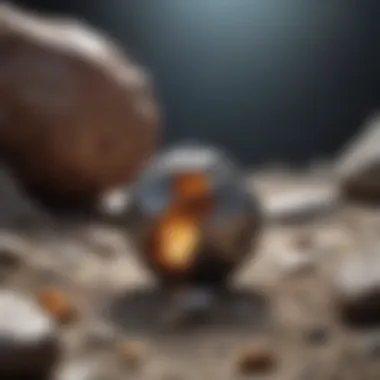Essential Rock Tumbling Supplies for Collectors


Intro
Rock tumbling, a favorite pastime for many collectors and hobbyists, breathes life into the beautiful stones unearthed from the depths of the Earth. The art of transforming rough rocks into polished gems is not only satisfying but also enriches one's appreciation for the natural world. As interest continues to grow, individuals are increasingly searching for insights into the essential components that make rock tumbling effective and enjoyable. This article seeks to bridge that gap, offering a closer look at the supplies that drive this fascinating craft.
Historically, the practice of rocking tumbling has roots that trace back many centuries. From ancient civilizations that valued ornamental stones to modern-day enthusiasts pondering the best techniques, it remains a continual thread in the tapestry of human interaction with geology. Understanding these historical elements alongside the right tools and methods is crucial for both appreciating the craft and mastering it.
History and Origins
Overview of Collectibles, Rocks, and Fossils
Rock tumbling has woven its way into the hobbyist culture significantly over recent decades. Collectors have always sought unique specimens, whether they come from local riverbeds or exotic landscapes. In the early days, the fascination was often simply with collecting—creating collections of unusual stones or fossils. However, as the understanding of geology expanded, the focus began to shift. People started to see beauty and potential in every rough stone, and tumbling became a way to reveal those hidden charms.
The resurrection of interest in geology during the 20th century saw the rise of specialized equipment designed for both the serious enthusiast and the casual hobbyist. From basic kits available in craft stores to advanced machinery built for efficiency, the market is teeming with options.
Historical Significance and Cultural Impact
What makes rock tumbling special isn't merely the end product, but also the journey each stone takes throughout the process. The act of tumbling has served as a means of connection. For many, it offers a retreat from the whirlwind of modern life, enabling a return to a simpler way of interacting with nature.
“Many hobbyists find that the soft hum of a tumbler brings not just sound, but a sense of calm.”
As tumblers come together—whether in local clubs or online—community bonds form over shared knowledge and experiences. Even today, social media platforms such as Facebook and Reddit are buzzing with dialogue among rock tumbling enthusiasts, creating a vibrant exchange of tips, tricks, and triumphs.
Identification and Classification
Guide to Identifying Rocks and Fossils
For newcomers, identification plays a pivotal role in the enjoyment of rock tumbling. Understanding the differences between types of stones and recognizing fossils can help hobbyists select the right materials for tumbling.
The main categories of identifiable rocks include:
- Igneous: Formed from cooled magma. Examples include granite and basalt.
- Sedimentary: Created from layers of sediment. Common examples are limestone and sandstone.
- Metamorphic: Originating from existing rocks subjected to heat and pressure, such as marble and schist.
Fossils, on the other hand, provide a fascinating bridge to the past—it’s like a snapshot in time. Recognizing factors such as texture and coloration can assist enthusiasts in identifying these treasures effectively.
Common Types and Variations
Hobbyists typically gravitate towards a variety of stones based on their beauty, rarity, and personal preferences. Some commonly tumbled stones include:
- Amethyst: A variant of quartz, known for its stunning purple hues.
- Agate: Recognized for its unique banding patterns and color variations.
- Jasper: A form of chalcedony that often features striking patterns.
Each of these offers its unique challenges and rewards in the tumbling process, making the selection of rocks not just a functional choice but also an art in itself.
As we dive deeper into rock tumbling supplies, it becomes evident that understanding the history and classification of materials enhances the experience and fosters a greater connection to this ancient practice.
Foreword to Rock Tumbling Supply
Rock tumbling is more than just a hobby; it’s a journey that transforms rough stones into polished gems. Understanding the right supplies is essential for every collector and hobbyist who wishes to delve deeper into this craft. High-quality supplies can make all the difference between mediocre results and breathtaking finishes. This section aims to illuminate various facets of rock tumbling supplies, emphasizing their significance in the process of tumbling and the resulting satisfaction that comes along with it.
Purpose of Rock Tumbling
The primary goal of rock tumbling is to refine uncut stones into smooth, polished rocks that can be used for jewelry, home decor, or simply for admiration. Engaging in rock tumbling offers numerous benefits:
- Skill Development: Tumbling teaches patience and precision, as achieving the desired results takes time and careful attention to detail.
- Creativity: It allows hobbyists to express their creativity, from selecting stones to designing jewelry.
- Learning Science: The process introduces concepts of geology and mineralogy, making it educational as well as enjoyable.
So, whether you're looking for a rewarding distraction or aiming to create collectible pieces, understanding the purpose of rock tumbling gives context to the supplies you'll need.
The Role of Quality Supplies
When it comes to rock tumbling, low-quality supplies can lead to disappointing outcomes. Quality tumblers, grit, and media are vital for several reasons:
- Durability: Higher-grade supplies last longer, preventing frequent replacements that can add up over time.
- Consistency: Quality supplies ensure uniformity in results; a dependable tumbler provides even pressure and rotation, yielding predictable finishes.
- Enhanced Results: Using suitable grit and media speeds up the process, yielding finer finishes and reducing wear and tear on equipment.
In the ecosystem of rock tumbling, it’s crucial to identify and source top-notch supplies to elevate your craft. As the proverb goes, "Don’t buy a pig in a poke"; be sure to thoroughly assess what you invest in.
Types of Rock Tumblers
Rock tumblers come in various forms, each serving distinct purposes that cater to different preferences and circumstances. Understanding these options is crucial for hobbyists and serious collectors alike, as the right tumbler can greatly impact the quality of the finished stones. From speed to finishing, the choice of tumbler makes a difference in how the rocks are treated and, ultimately, how well they shine.
Vibratory Tumblers
Vibratory tumblers are designed to shake rather than roll, making them a unique choice for enthusiasts. These machines typically have a flat base that vibrates, causing the media and rocks to move in a fast, efficient manner. One of their main benefits is the speed of the tumbling process. Generally, they can produce results in a fraction of the time compared to rotary tumblers. This feature appeals to those who may want quicker gratification in seeing their rocks polished and ready for display.
However, there are considerations to keep in mind. For instance, vibratory tumblers can be a bit rougher compared to their rotary counterparts. If not monitored closely, they can over-polish or create unwanted flat spots on the rocks. So, those who choose this method should pay attention to the type of media used and frequently check on the progress.


Rotary Tumblers
Rotary tumblers are more traditional in design, utilizing a barrel that spins continuously. They excel at giving rocks a more rounded, polished finish. Their operation is more simplistic, making them user-friendly for beginners. The gradual rotation helps to evenly distribute the grit and media around the rocks, minimizing the risk of flat spots. One striking characteristic of rotary tumblers is the versatility in grit selection; hobbyists can experiment with various grits over extended periods to achieve their desired polish.
However, on the downside, rotary tumblers can be quite slow. It’s not uncommon for a full tumbling cycle to take several weeks. For collectors who are patient, this may not pose a significant problem, but it does require some dedicated planning, especially if you want to showcase rocks at a certain event or gathering.
Hybrid Models
Hybrid tumblers marry the two concepts of vibratory and rotary tumblers, offering the best of both worlds. They operate with an unpredictable mix of movements, utilizing both rotation and vibration to polish stones. Hybrid models tend to be more advanced, often incorporating features from both types to enhance efficiency and finish quality. For those serious about rock tumbling, these machines can present a mid-range price point and performance that may appeal to serious hobbyists.
While they can achieve impressive results, hybrid tumblers do have a learning curve. The settings may vary based on the type of stones used or the desired finish, requiring users to experiment and develop a sense of timing and grit calibration.
In summary, whether you opt for a vibratory tumbler, a rotary tumbler, or a hybrid model, each type offers unique advantages and drawbacks. Understanding these intricacies can mark the difference between a mediocre polish and a breathtakingly lustrous finish.
Essential Components of Rock Tumbling
The journey into rock tumbling begins with understanding its essential components. Collectors and hobbyists alike find that the quality of these components greatly affects the final result of their efforts. Essentially, having the right tumbling supplies can mean the difference between a dull, lackluster stone and a beautifully polished gem that might catch the eye of any onlooker. This section focuses on the pivotal elements that make up the foundation of successful rock tumbling, outlining specific benefits and considerations vital for anyone engaged in this hobby.
Tumblers Explained
Rock tumblers are the heart and soul of the tumbling process. They come in various shapes and sizes, each designed to work a bit differently, yet all serving the same primary purpose: polishing rocks and stones to a high shine.
In broad strokes, tumblers can be categorized into three types: rotary, vibratory, and hybrid. Rotary tumblers, for instance, use a rolling barrel to create a slow, continuous grinding action—ideal for larger, rough stones. Vibratory tumblers, meanwhile, offer a faster, more aggressive movement that can yield quicker results. Hybrid models blend the mechanisms, providing flexibility depending on the type of rock and desired outcome.
It's crucial to assess not only the internal components of the tumbler but also its overall construction. A well-built tumbler can withstand the rigors of repeated use, reducing the risk of breakdowns that could interrupt your polishing journey. Keep an eye out for features like rubber lining and durable motors, as they significantly enhance the lifespan of the equipment.
Rock Media and Grit Types
Next in line are the various rock media and grit types used during the tumbling process. Rock media can include materials such as ceramic chips, plastic pellets, or even stainless-steel balls, each serving a unique role in facilitating that all-important polishing action. Choosing the right media is sensitive to the type of stones being tumbled; for example, gentler media may be more appropriate for softer stones to prevent any unwanted scratches or damage.
Grit types come into play also, categorized by coarseness. Coarse grit starts the shaping and smoothing process, while finer grit progressively refines the surface, leading to the high shine that enthusiasts seek. Typical grit types range from 60/90 for coarse grit to 1200 for the finishing polish. The choice of grit ultimately defines how long the tumbler will need to run and how favorable the final results will be.
Grit Selection Best Practices
Selecting the right grit is an art in itself. When beginning, many rock tumblers might feel lost among the various options available. A few best practices can streamline this process:
- Inspect the Rock: Check the hardness and texture. Softer stones often require a gentler approach.
- Understand the Stages: Move through the grit selection in a logical progression—coarse to fine—to gradually polish your stones.
- Consider Mixing: Sometimes mixing different grit types can lead to unexpected yet favorable outcomes.
- Monitor Results: Keep a close watch on the stones as they tumble. If they seem to be losing shape too quickly, consider switching to a finer grit sooner than planned.
As a part of a well-rounded tumbling strategy, paying attention to these details and adhering to these practices ensures that you'll achieve the polished results you aspire to, making each tumbling session both an educational and rewarding experience.
Selecting Quality Supplies
Selecting quality supplies for rock tumbling is not only essential but also pivotal for achieving great results in your tumbling endeavors. When you invest time, energy, and hard-earned cash, the last thing you want is to end up with subpar equipment that turns your beautiful gemstones into mediocre pebbles. Quality supplies can elevate the tumbling process, enabling you to transform ordinary rocks into polished gems. Let’s dive deeper into the critical elements that comprise this selection process.
Assessing Tumblers
When it comes to rock tumbling, the first order of business is an appropriate tumbler. There are various brands and types out there, and not every one of them is created equal. Here are a few pointers to think about when assessing tumblers:
- Durability: Look for tumblers that are made of sturdy materials. Plastic seems cheaper but may not hold up against the wear and tear of tumbling; metal options are generally more robust.
- Motor Efficiency: A powerful motor will ensure that the tumbler runs smoothly and saves you from frequent mechanical failures. Many models also come with adjustable speed settings, which can be a real game-changer for different types of stones.
- Capacity: Assess the tumbling capacity to match your workload. A tumbler that's too small may require multiple batches, while an overly large one may lead to inefficient processing of smaller rocks.
By assessing your tumbler thoroughly, you set a solid foundation for your future rock polishing endeavors.
Sourcing Grit and Media
Choosing the right grit and media is like the spice in a recipe; it can make or break your results. Sourcing high-quality grit is important as it determines the effectiveness of your tumbling process. Here are a few things to keep in mind:
- Type of Grit: There are several types of grit available, such as silicon carbide, aluminum oxide, and more. Each has different cutting abilities and is suited to different stones. For instance, harder stones may require a more abrasive grit.
- Freshness: Once grit sits around for too long, it can lose its effectiveness. So, try to source your media from reputable suppliers who sell fresh products.
- Ecological Compliance: Sustainability matters. Look for brands that focus on sourcing their materials responsibly. Not only is this good for the planet, it's often good for your rock tumbling outcomes, too!
Knowing where your grit is coming from can positively impact both your results and your conscience.
Evaluating Accessories
Accessories may seem like add-ons, but choosing the right tools can significantly affect your tumbling results. When evaluating accessories, ask yourself these questions:
- What do I need? Consider a basic kit which includes essential items such as polishing powders or various grades of grit. Make sure they are compatible with your tumbler and stones.
- Quality Over Quantity: Just because it’s cheap doesn’t mean it’s effective. Evaluate the quality of accessories like liners or containers; low-quality versions can lead to mess or mishaps during your tumbling cycle.
- User Reviews: Platforms like Reddit can provide insights into what accessories fellow enthusiasts swear by. Peer feedback can guide you toward or away from specific products.
When it comes down to it, investing in quality accessories can make your rock tumbling journey smoother and more rewarding. In the long haul, the right supplies can save time, hassle, and money.
“The right tools make all the difference between a hobby and a passion.”
In essence, selecting quality supplies is about understanding the interplay of equipment, materials, and accessories in the rock tumbling process. By carefully considering each element involved, you pave the way for a fruitful and enriching tumbling experience.
Techniques for Effective Tumbling


Understanding the art of rock tumbling goes beyond merely having the right equipment. Techniques for effective tumbling play a crucial role in the overall success of your rock polishing journey. While every hobbyist may have their individual preferences, certain practices can significantly enhance the quality of the end results. Whether you’re a novice seeking to produce beautifully polished stones or an aficionado looking for that perfect sheen, honing your techniques will certainly make a notable difference.
Preparing Rocks for Tumbling
Before the tumbling begins, preparing your rocks is essential. Each rock has its own characteristics, and this variety necessitates a thoughtful approach. First and foremost, sorting rocks by hardness is a key element. Softer stones can easily become damaged if tumbled alongside harder varieties. For instance, mixing calcite with quartz is generally a no-go, as the softer stone will wear down faster.
Next, washing the stones is another important preparatory step. A quick rinse to remove dirt, grime, and impurities not only helps in making the tumbling process more efficient but also ensures a cleaner polish. Rocks with a rough exterior should be ground down using a coarse grit in the first stage, which aids in shaping your stones into the desired contours.
Lastly, check for any existing fractures or cracks. If a rock shows signs of these, it might be better to set it aside for a later stage of tumbling or to find a more sturdy substitute.
Tumbling Process Overview
Once your rocks are prepped, it’s time to tackle the tumbling process itself. This phase is where the magic happens and requires a delicate balance of grit type, duration, and rock quantity. Generally, you’ll start with coarse grit, which helps shape and smooth out imperfections. A common grit sequence might look like:
- Coarse Grit (60/90) – for shaping the rocks.
- Medium Grit (120/220) – for refining shapes.
- Fine Grit (500) – for polishing.
- Polishing Powder – the final touch for that glossy finish.
The length of the tumbling time is variable; however, patience is key. For the coarse grit, you might need to let the tumbler run for about a week, depending on the condition of the stones. Pay attention to the sound your tumbler makes—it can often give you clues. If it sounds too harsh, it might be a signal to add more media to cushion the rocks.
Final Polishing Techniques
Once the tumbling process is concluded, you’ll be eager to see the fruits of your labor. However, achieving that ultimate polish might require a few extra techniques to ensure your stones shine bright. A critical step here is the final cleaning stage. Remove rocks from the tumbler and wash them thoroughly to eliminate any residual grit. It’s almost like sending your stones off to a spa before their big reveal.
Following this, you’ll want to introduce a polishing compound designed specifically for rock tumbling such as cerium oxide or aluminum oxide. These are often mixed with water to facilitate the polishing process in a clean tumbler. Adding them into their own batch is advisable since this is the most delicate phase of the operation.
Additionally, the right environment plays a role in the final polish. Low humidity and dry air help in the setting of the polish and can make an incredible difference in achieving that desired shine.
In essence, effective techniques in rock tumbling not only yield superior results but also transform the whole experience into a satisfying venture.
Utilizing the right preparation, a conscientious tumbling process, and adaptable final polishing techniques are invaluable aspects that can elevate your rock tumbling hobby to new heights.
Maintaining Tumbling Equipment
Maintaining tumbling equipment is not just a task; it’s a commitment to ensuring that your rock tumbling journey is fruitful. Just like a craftsman who cares for their tools, hobbyists must recognize the significant role maintenance plays in extending the lifespan of their tumblers. Well-maintained equipment leads to smoother operations, more efficient tumbling, and ultimately, better finished rocks. Neglecting this aspect can result in costly repairs or even the need for replacements. Hence, it’s crucial to focus on specific maintenance tasks, troubleshoot common issues effectively, and know when parts need replacing.
Routine Maintenance Tasks
Regular maintenance tasks create a solid foundation for keeping tumbling equipment in peak condition. These tasks might seem mundane but can save a lot of heartache down the road:
- Cleaning: Always clean the tumblers and barrels after each use. Any leftover grit or debris can affect the next batch. A simple rinse with soap and water usually does the trick.
- Lubrication: Many tumblers have moving parts that need a bit of lubricant to minimize wear and tear. Check the manufacturer's guidelines for what type to use.
- Inspection: Periodically inspect hoses, containers, and seals for wear. Look for cracks, frays, or areas that may need attention.
- Calibration: Ensure that your tumbler is calibrated correctly. Some models may require adjustments to maintain even rotation. This prevents uneven results during tumbling.
Sticking to a routine can make all the difference. You’re not only caring for your tools but also committing to consistency in the quality of your polished stones.
Troubleshooting Common Issues
Even with regular maintenance, problems can arise. Understanding common issues and their solutions is key to a smooth tumbling experience:
- Noisy Operation: If your tumbler begins to make an unusual noise, it may indicate that something is off-balance or that a part is loose. Stop the tumbler, inspect the barrel, and tighten any loose components.
- Leaking: If you notice grit or water leaking from the tumbler, check the seals and gaskets. Over time, these components can wear down and may need replacement.
- Insufficient Polishing: If your rocks aren’t coming out as smooth as expected, it might be due to improper grit selection, too little or too much grit, or an uneven mix of materials. Revisiting your grit strategies is key here.
Being proactive about troubleshooting can save you time and frustration.
When to Replace Parts
Knowing when to replace parts is just as crucial as regular maintenance. Some telltale signs indicate that a part is nearing the end of its life:
- Visible Damage: Cracks or significant wear in the barrel or seals mean it’s time for replacements. Continuing to use damaged parts may lead to worse issues.
- Performance Issues: If your tumbler is struggling to perform despite regular maintenance, it might indicate that parts are worn out. A tumbling barrel that doesn’t seal properly can cause slipping or loss of grit, affecting your project's outcome.
- Vibration Problems: Excessive vibrations that weren’t there before can signify loose or worn parts needing attention. If you’ve attempted tightening and lubrication and issues persist, it could be time to replace some components.
Keeping a good eye on these factors will help ensure that your tumbling equipment serves you well. Remember, a reliable tumbler translates into successful rock polishing projects, and maintaining it is key to an enjoyable hobby.
Safety Considerations in Rock Tumbling
Rock tumbling can be a rewarding hobby, but safety should be at the forefront of your mind. It’s not only about the joy of transforming rough stones into polished gems; awareness about safety can help you avoid mishaps that could put a damper on your excitement and progress in this fine craft. Here, we will delve into some basic yet crucial safety elements, exploring the benefits of protective gear, proper ventilation, and other pertinent considerations.
Protective Gear and Precautions
First off, investing in protective gear is not a luxury—it's a necessity. When you're dealing with machinery and materials that can kick up dust or potentially cause harm, being well-protected is key. Here’s a list of essential gear to consider:
- Safety Goggles: Protect your eyes from dust and debris. You wouldn’t want a rogue piece of rock to ruin your day, right?
- Dust Masks: These are crucial for filtering out fine particles that can cause respiratory issues. Breathing clean air should be a priority.
- Gloves: Using gloves protects your hands from cuts or abrasions caused by sharp-edged rocks.
- Ear Protection: If you’re using loud rotary tumblers, earplugs can help mitigate hearing damage over time.
Additionally, ensure that your workspace is clean and organized, minimizing the risk of accidents. A cluttered workspace is an accident waiting to happen. Making it a habit to maintain a tidy environment goes a long way.
"An ounce of prevention is worth a pound of cure."
Prevention is all about being proactive, so regularly check your equipment for any wear and tear. Identifying issues before they escalate can save you from physical harm and costly repairs.


Ventilation Needs
Ventilation is another important aspect of safety that cannot be overstated. Tumbling generates dust, and in many cases, that dust can contain harmful particles. If you’re working in a confined space, air quality can quickly deteriorate, leading to various health concerns. Here are some suggestions to ensure good ventilation:
- Work in Open Areas: If possible, do your rock tumbling outside or in a well-ventilated shed. Fresh air can help to disperse harmful particles.
- Use a Fan: A simple box fan can keep the air circulating, pushing dust away from where you’re working. It's an easy way to enhance your environment.
- Air Purifiers: Consider investing in air purifiers that can specifically filter out dust and other fine particles.
In summary, proper ventilation not only makes your workspace more comfortable but also drastically reduces the health risks associated with long-term exposure to dust.
When engaging in rock tumbling, it’s vital to prioritize safety measures through protective gear and adequate ventilation. These actions not only create a safer environment but also enhance your overall tumbling experience.
Environmental Impact of Rock Tumbling
Rock tumbling combines the art of polishing stones with a keen emphasis on environmental stewardship. As rock collectors and hobbyists embark on this journey, it's vital to understand the ecological footprints left behind, both positive and negative. This section will dive into how sourcing materials and managing waste contributes to a sustainable and responsible hobby. Awareness of these aspects not only enhances the practice but also helps in preserving the natural beauty of the Earth's resources.
Sourcing Materials Responsibly
When chasing the perfect stones for tumbling, many enthusiasts overlook the impact of their material choices on the environment. Sourcing materials responsibily is paramount. Here are a few key considerations:
- Local Sourcing: Opting for local rocks minimizes the carbon footprint associated with transportation. Gathering stones from nearby areas reduces the need for long-distance shipping, which is often fossil fuel-intensive.
- Ethical Harvesting: Always abide by collecting laws and regulations. For instance, avoid collecting from protected areas or sites designated for conservation. This includes beaches and national parks, where the ecosystem might be disrupted.
- Choosing Sustainable Suppliers: If purchasing materials, seek suppliers who emphasize sustainable practices. Look for those who engage in ethical extraction and who offer products sourced from responsible environments - this can make a world of difference.
"Responsible sourcing isn’t just smart; it’s a way to show respect for the natural world that provides us with these beautiful materials."
Waste Management in Rock Tumbling
Waste management is another crucial element of the environmental equation. Practicing effective waste management not only supports sustainability but also encourages a cleaner, less wasteful hobby. Here are some strategies:
- Reducing Waste: Always aim to minimize waste wherever possible. This could mean reusing grit, or repurposing spent materials for road base or landscaping. Think creatively before throwing things out.
- Proper Disposal: For any materials that cannot be reused, it’s essential to dispose of them correctly. Many towns have specific guidelines for disposing of chemical waste used in rock tumbling, so checking local regulations can help keep the environment safe.
- Create an Eco-Friendly Setup: Utilize containers and equipment that are eco-conscious. This might include selecting a tumbler with a longer lifespan or using biodegradable materials in your work area.
Taking these steps in waste management greatly supports the sustainability movement in hobbyist activities while ensuring the continuation of rock tumbling for future generations. An appreciated hobby like rock tumbling can have a lesser footprint when enthusiasts are vigilant about their practices.
Community Resources and Networks
Community resources and networks play a vital role in the world of rock tumbling, especially for enthusiasts and collectors. These connections can provide invaluable insights, support, and friendships that enhance the overall experience of rock tumbling. Engaging with like-minded individuals opens doors to new ideas, techniques, and opportunities that might otherwise go unnoticed.
Joining Rock Tumbling Clubs
Joining a rock tumbling club can be one of the Best decisions for both novice and seasoned tumblers alike. Such clubs offer a sense of belonging and establish a community where members can share experiences, challenges, and triumphs. Members can gather to exchange tips on tumbling techniques, discuss optimal grit types, and even trade rocks or supplies.
- Networking: The relationships formed in these clubs can lead to collaborations on projects or sharing of equipment.
- Workshops and Events: Clubs usually host workshops or demonstrations, providing hands-on learning in a supportive environment.
- Show and Tell: Members often showcase their polished rocks, inspiring others and giving feedback that might be hard to find elsewhere.
Moreover, some clubs maintain online platforms where discussions can continue even when members aren’t physically together. The sense of community can foster motivation, and you might find that your skills improve as you learn from others.
Educational Platforms and Forums
In addition to clubs, educational platforms and forums serve as a treasure trove of knowledge about rock tumbling. These online communities are great resources for individuals seeking information on specific challenges, best practices, or innovative techniques. Here are some key benefits:
- Access to Experts: Many forums host experienced tumblers willing to share their expertise, offering tailored advice based on practical experience.
- Diverse Topics: From sourcing materials to polishing techniques, discussions can range widely, allowing members to gain insights on various aspects of the craft.
- Support Network: Questions can be answered almost instantly, connecting enthusiasts globally, which can be particularly helpful for hobbyists in remote areas.
Culmination
Whether through local clubs or online forums, maintaining connections within the rock tumbling community enriches the entire experience. It allows collectors and hobbyists to continuously learn, improve, and stay updated on emerging trends and tools. Scavenging unique insights from a variety of sources can bridge the gap between simple hobby work and a profound passion for this craft.
"Engagement in community can turn the solitary act of rock tumbling into a shared journey of discovery and creativity."
By participating actively in these networks, you'll not only improve your own tumbling endeavors but also contribute to a collective endeavor that promotes growth and appreciation for the art of rock tumbling.
Culmination and Future Perspectives
As we wrap up our discussion on rock tumbling supply, it is essential to recognize the significant role this topic plays in the broader context of rock and mineral collecting. The art and skill of rock tumbling not only enriches personal collections but also fosters a sense of community among enthusiasts. By diligently selecting quality tumbling equipment, understanding grit types, and utilizing effective techniques, tumblers can elevate their craft to remarkable levels.
Looking ahead, the future of rock tumbling supplies offers exciting possibilities. The emergence of advanced materials and innovative designs promises to make the tumbling process more efficient and enjoyable than ever before.
Emerging Trends in Rock Tumbling Supplies
One of the notable trends we are witnessing is the increasing availability of specialized tumblers tailored to distinct purposes. For instance, there are now models designed specifically for polishing softer stones while preserving their characteristics. This bespoke approach allows hobbyists to cater their activity to the unique attributes of different rocks, enhancing the results significantly.
Furthermore, with sustainability at the forefront of environmental awareness, many manufacturers are now prioritizing eco-friendly materials in their tumbling equipment and abrasive media. This shift not only reduces the ecological footprint of rock tumbling but also appeals to a new generation of collectors who value sustainable practices.
Lastly, the growth of digital platforms and community forums has resulted in a wealth of resources that can help both novices and experienced tumblers. Online marketplaces frequently introduce trending products, vibrant discussion boards on sites like Reddit and specialized Facebook groups provide grassroot connectivity that encourages sharing techniques and experiences.
Advice for Aspiring Tumblers
If you’re new to the world of rock tumbling or considering delving deeper into this hobby, here’s some practical advice. First, do your homework. Understanding the differences between various tumblers and the types of media is crucial. A rotary tumbler could be excellent for beginners due to its straightforward operation, while a vibratory model might suit those looking for faster results.
Start small. Begin with a manageable amount of stones, and gradually expand as you become familiar with the process and what works best for you. Keeping a tumbler journal can be beneficial—recording different settings, types of grit used, and results helps refine your technique.
Lastly, engage with the community. Participate in forums or local clubs to gain insights from those who share your passion. Learning from others' experiences can be invaluable in overcoming initial hurdles and making the most of your tumbling journey.
Remember, each tumbler has its rhythm; patience is key in achieving that perfect shine.



